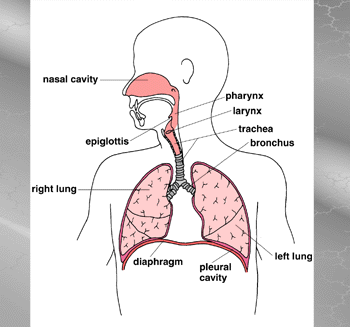Snot and Boogers |
|
An Introduction to the Respiratory System
Ever
wonder what snot is for? Its real
name is mucus and it is a slippery liquid that is mixed with a special
bacteria-killing chemical. Most
people are surprised to learn that it is clear.
When you blow your nose, however, it may be a yellowish green because
it is mixing with gunk from the air. When
you have a cold, it is that color because it is mixed with bacteria and their
wastes. (That's why you should
throw away your dirty tissues and wash your hands!)
Its job is to prevent junk from reaching your lungs.
To prevent the mucus from dripping out of your nostrils, the nose is
filled with hairs. Some of these
are big and coarse to trap stuff in the air and form boogers. (More about that
later.) The smaller hairs are
called cilia that beat and wipe away air trash.
The dirty snot is dumped down a garbage shoot that we call a throat.
When you swallow it, your stomach destroys germs and other stuff that
you breathe in.
What happens if the cilia don't work?
If you go from a warm place to a cold one, the cilia slow down and
guess what - your nose starts to run! If
your sinuses are blocked (air spaces in your skull), the mucus sits
there and you get a stuffed nose. To
make it worse, the cilia can't clean the nose so that the snot gets dirtier
and bacteria begins to grow.
Boogers are actually nose garbage.
Each day you breathe in air that is filled with dust, smoke, grit,
bacteria, fungi, soot, fuzz, sand, metal pieces, etc.
The rough hairs, known as vibrissae (it's the same word for cat
whiskers) trap this garbage in a sticky liquid we already learned about,
mucus. The sticky trapped
stuff clumps together and a real booger is formed.
You can know blow it out, breathe it in or pick it.
In fact, 70 out of 100 people admit to picking them.
Now let's learn more about the…….
Respiratory
System
1. What is the function
of the respiratory system?
2. Using the diagram
provided by your teacher, identify
and color (click on Human Body) in the parts of the respiratory
system. Give the function of each part.
3. Using the above
diagram, trace the
path of an oxygen molecule from the time it enters the nostril until it
enters the blood.
4.
List two factoids
about the respiratory system.
5. Explain how air can
enter and leave the lungs without you even thinking about it.
( mechanics
of inhalation and exhalation) See
it in action!
6. What is the epiglottis?
7. What are hiccups?
8. Explain the
following diseases
that can result when homeostasis isn't maintained in the respiratory system.
Ø
Asthma
Ø
Bronchitis
Ø
Cystic fibrosis
Ø
Pneumonia
Ø
Free choice!


